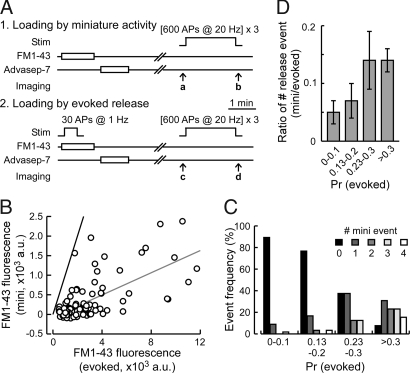Fig. 2.
Background miniature activity does not significantly affect the estimation of pr by FM1-43. (A) Experimental scheme for comparing miniature spontaneous activity and evoked release. In the first session, FM1-43 was loaded by spontaneous activity, whereas in the second session FM1-43 was loaded by 30 APs at 1 Hz. Fluorescence signals from spontaneous miniature and evoked events were obtained by subtracting the unloaded image: a–b (spontaneous activity) or c–d (evoked response). (B) Scatter plot showing FM1-43 fluorescence intensities loaded by field stimulation (evoked) and spontaneous miniature activity (mini). The gray line is a linear regression fit with a slope of 0.142, and the black line has a slope of 1. Data from 107 regions of interest from three coverslips are shown. (C) Synapses are classified by their pr, and the distribution of the miniature endocytotic event frequency is shown for each group. FM1-43 fluorescence intensity shown in B is converted to pr for evoked events. Higher pr synapses tend to show higher miniature synaptic activity (r = 0.65, P < 0.0001, Spearman correlation), although the overall contribution of miniature activity is small. (D) Ratio of the number of miniature release events to that of evoked release at individual synapses as a function of pr (evoked). On average, the uptake of FM1-43 by miniature synaptic activity contributes to ≈7% of our estimation of pr. Data are shown as mean ± SEM.

